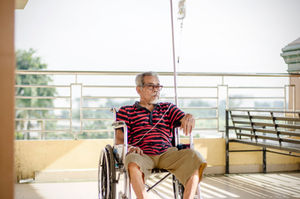COPD and Mental Health: The Overlooked Connection By Dr. Mark Esterle, MD
- Mark Esterle, MD

- May 14
- 4 min read
Hi everyone,
It’s been a while—welcome back! The last time I posted was before the COVID-19 pandemic, and like many of you, I spent those uncertain years learning, adapting, and simply trying to keep up. I didn’t feel right publishing content when so much was evolving daily. But now, I’m ready to reconnect and start sharing again—starting with something deeply important to me and, I believe, to many of you: the connection between COPD and mental health.
The Hidden Burden: Anxiety and Depression in COPD
If you or a loved one lives with Chronic Obstructive Pulmonary Disease (COPD), you already know how challenging it can be. But what’s often less talked about is how COPD affects your mental and emotional health.
Did you know that nearly 40% of people with COPD experience depression, and around 36% struggle with anxiety? That’s far higher than in the general population. And yet, mental health is often overlooked in COPD care.
Why does this matter? Because depression and anxiety don’t just affect how you feel—they can make your COPD symptoms worse. When you feel breathless, you may become anxious, which tightens your breathing even more. It’s a tough cycle, and it’s easy to feel stuck.
Why Mental Health Often Goes Unnoticed
There are a few reasons why emotional health tends to get lost in the shuffle:
Symptoms overlap: Fatigue, sleep problems, and lack of energy can be signs of both COPD and depression, making it hard to tell them apart.
Short appointments: During check-ups, the focus is usually on your breathing and physical symptoms—not your mood or worries.
Fear of stigma: Many people don’t want to admit they feel down or anxious. It can feel like “just part of being sick.”
Lack of routine screening: Unlike lung function tests, mental health assessments aren't always built into COPD care plans—but they should be.
What to Watch For
If you’re living with COPD—or caring for someone who is—here are a few signs that might signal depression or anxiety:
Feeling persistently sad, hopeless, or emotionally flat
Avoiding social activities or things you used to enjoy
Constant worry about breathing problems or flare-ups
Panic or fear during shortness of breath
Trouble sleeping (more than usual)
Changes in appetite or weight
Difficulty focusing or remembering things
Feeling irritable or on edge
These symptoms aren’t just “in your head”—they’re real, and they deserve attention.
Simple Tools That Can Help
There are quick and easy ways to screen for depression and anxiety right in the clinic or even at home:
HADS (Hospital Anxiety and Depression Scale): Designed specifically for people with chronic illness.
PHQ-9: A 9-question tool to spot depression.
GAD-7: A 7-question screening for anxiety.
If you’re curious, ask your provider about them—or even look them up online and bring the results to your next visit.
What Treatment Can Look Like
If mental health concerns show up, there’s good news: there are many ways to feel better, and you don’t have to tackle this alone.
Medications:
SSRIs (like sertraline or escitalopram) are often safe and helpful for mood issues in COPD.
Anti-anxiety meds may be used short-term, but need careful monitoring due to breathing risks.
Therapy & Support:
Cognitive Behavioral Therapy (CBT) can teach you how to break the anxiety-breathlessness cycle.
Pulmonary rehab programs that include stress management and breathing techniques are incredibly effective.
Mindfulness or relaxation practices can calm both body and mind.
Lifestyle changes:
Gentle physical activity (even just walking) improves both mood and breathing.
Better sleep habits can ease both depression and COPD symptoms.
Support groups (online or in-person) can connect you with others who truly understand.
The Future of COPD Care: Whole-Person Wellness
The best care happens when physical and mental health are treated together. More clinics are starting to integrate mental health support into their COPD programs, which is wonderful to see. Some offer:
Regular mental health screenings
On-site counselors or telehealth therapy
Group programs for breathlessness and anxiety
Collaborative teams of pulmonary and mental health specialists
This is the direction we need to move in—and it’s what I hope to help provide more of.
What You Can Do Today
If you’re living with COPD:
Talk to your provider about how you’ve been feeling—emotionally as well as physically.
Don’t downplay feelings of sadness, fear, or stress. They’re just as important as your oxygen levels.
Ask about support groups or therapy options in your area or online.
Be kind to yourself. Living with COPD is hard enough—you deserve support for the whole you.
If you’re a provider or caregiver:
Be proactive in asking about mood, anxiety, and quality of life—not just symptoms.
Use tools like the PHQ-9 or GAD-7 regularly.
Build relationships with mental health providers who understand chronic illness.
Help normalize these conversations. Mental health is health.
Wrapping Up
I’m so glad to be writing again and reconnecting with you all. The intersection between COPD and mental health is one of the most important conversations we can have. It’s not just about managing a disease—it’s about helping people feel better, breathe easier, and live fuller lives.
As always, I welcome your thoughts, stories, or questions in the comments below. Let’s keep learning—and healing—together.
Warmly,
Dr. Mark Esterle, MD











“I struggled with Idiopathic Pulmonary Fibrosis and Irritable Bowel Syndrome for 6 years. After beginning a wellness program at Earthcure Herbal Clinic (www.earthcureherbalclinic.com), my breathing, digestion, and energy improved so much that I can finally live freely without being tied to oxygen or constant discomfort. I never thought I’d find relief from these conditions, but thanks to Earthcure Herbal Clinic’s natural treatment program, my life has completely changed. Truly life-changing!”
If you're preparing for a doctor's appointment to discuss anxiety, it can be really helpful to have some data. Taking the GAD-7 beforehand gives you a clear score to share, making it easier to describe your symptoms and their severity.
For the past few years I have had difficulty working out in the yard, and then in 2018 it got harder and harder to breathe. After many tests, it was a CT scan that showed Emphysema, and scarring in my lungs. I quit smoking 8 years ago, but the damage has been done. I got to a point I couldn’t catch my breath and was coughing so hard I thought the top of my head would blow off; nothing was really working to help my condition. Finally, I started on the COPD formula, and with the help of this treatment, I’m active again. Its effects on emphysema are amazing; all my symptoms gradually faded away. I breathe much more freely…